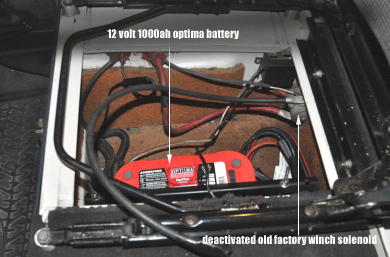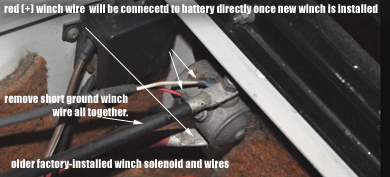 Defender 110 Battery |
|
When
is it time to replace my battery? What kills a battery? Heat, vibration, corroded cables and terminals, lack of electrolyte maintenance, sulfating, alternator/regulator malfunction, and electric shorts are the most common causes of harm to the battery. Left untreated, they will eventually kill the battery. Where's my battery? Defender's battery compartment is located under the driver's seat. At first glance, it's a a bit concerning to move the driver's seat cushion and compartment lid to find a loaded battery capable of generating 6,500 to over 12,000 watts of power right under. A closer look, however, reveals the battery compartment's metal cover plate, all aluminum side walls with fire retardant insulation, and the driver's seat's bottom metal plate which together well-assure adequacy and protection. The battery compartment can accommodate one additional/auxiliary battery tightly installed, used for back up purposes, isolated or installed in series as needed. |
If you plan to install a SuperWinch and you plan to use it often, then you certainly will benefit from having a second battery that does not drain your main battery. That said, when installed in series, the alternator will charge the primary and second battery at nearly the same rate and over-discharge may lead to two failed batteries. For this reason, if you plan to install a winch-dedicated battery, it is advised to use an in-line shut-off regulator/sensor to avoid over-discharging the primary battery. The 1000amp red label Optima battery shown here has reasonable power to spare and is a reliable choice for occasional winch and auxiliary light usage. Anything less for your expedition-ready Defender is a compromise.
What's this thing in my battery compartment? Your original Solenoid, most likely. For the most part, the stock NAS 93 Defender 110 came with a winch. The original Warn winch was directly grounded to the vehicle's chassis. As we all know today, grounding high current equipment to vehicle chassis is not recommended mainly due to the fact that high current traveling through the chassis can leak back into unintended and unprotected low current components in the event of failure and start a fire as a result. Even without a fire, it can cause damage other electronics. Another reason involves simple current laws--the larger the resistance (frame/chassis in this scenario), the less efficiency. Increased resistance = decreased efficiency, translating to, more juice out of the battery and less battery life. The pictures show the factory solenoid installed supporting a factory-shipped winch. The thin red and white wires are original remote cable wires The thick ground (black) wire (also original) connects the solenoid to the battery ground terminal, and the thick lead (red) wire along with remote wires go through the battery compartment, travel under the body, and travel under the hood directly to the winch and the bumper. For more information regarding winch installation visit the Winch Installation page. |
|
Table of Contents • DefenderHelp.com is an
independently owned and operated web
site intended to help Defender 110
owners and is not associated
with any manufacturer, vendor, or
commercial entity unless otherwise
mentioned clearly. We do not
endorse vendors or products unless we
test them, use them, like them, and
find sharing the information
beneficial to other Defender 110
owners. Visitors may view
and use this web site at their own
risk. All information and content here
is provided for free. All rights
reserved. Copyright DefenderHelp.com
|

